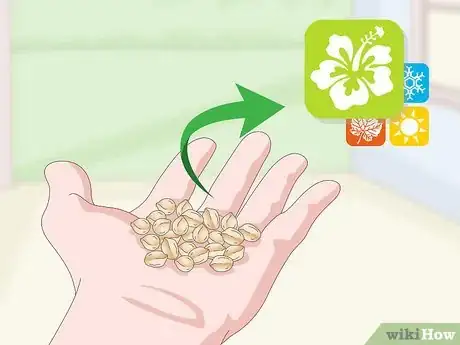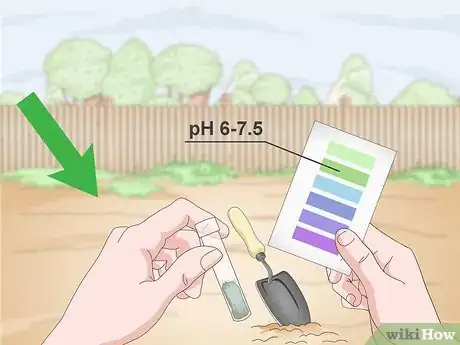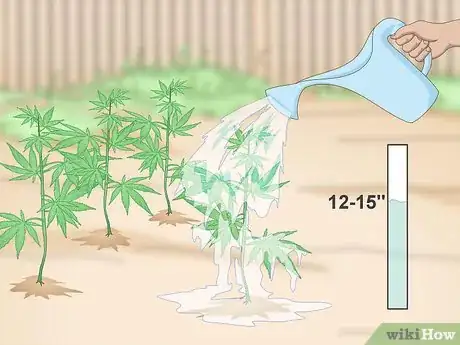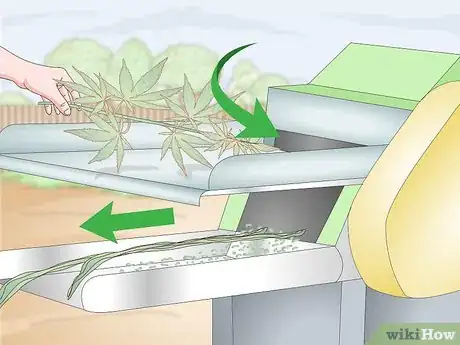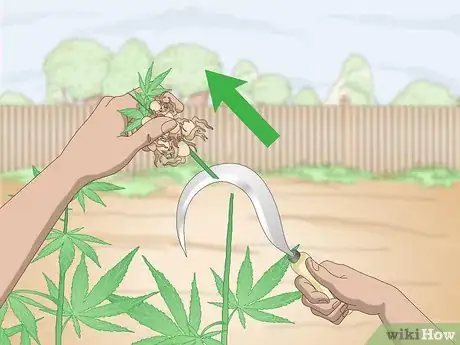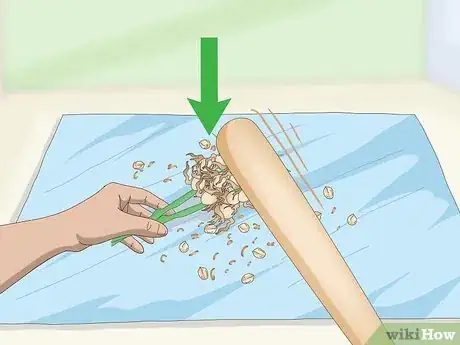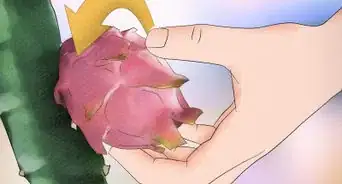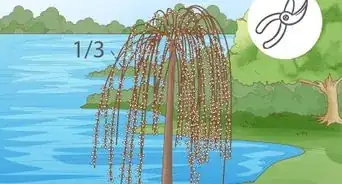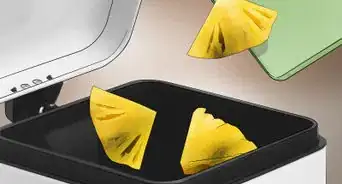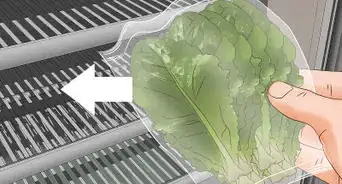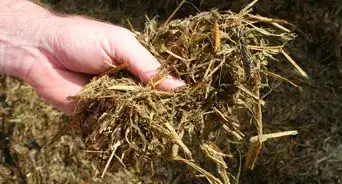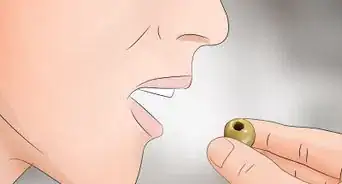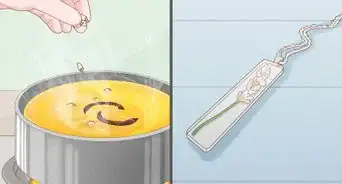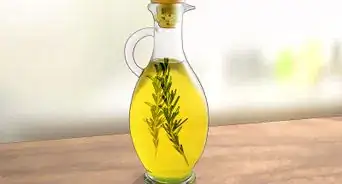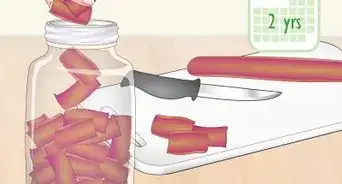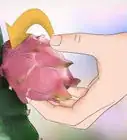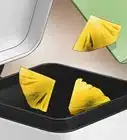This article was co-authored by wikiHow staff writer, Hunter Rising. Hunter Rising is a wikiHow Staff Writer based in Los Angeles. He has more than three years of experience writing for and working with wikiHow. Hunter holds a BFA in Entertainment Design from the University of Wisconsin - Stout and a Minor in English Writing.
There are 8 references cited in this article, which can be found at the bottom of the page.
wikiHow marks an article as reader-approved once it receives enough positive feedback. In this case, 91% of readers who voted found the article helpful, earning it our reader-approved status.
This article has been viewed 115,612 times.
Learn more...
Hemp is a hardy plant used for textiles, paper, animal feed, and much more. While hemp is typically grown for industrial purposes, it’s also a plant you grow on your own. After planting the seeds in the spring and caring for them through summer, you can harvest the fibers and seeds to use. But before you start a crop, make sure to check your local laws to see if it’s legal to grow hemp in your area!
Steps
Planting Seeds
-
1Plant hemp seeds in late spring. Wait until after the last frost to plant hemp seeds. Check the temperature 1 inch (2.5 cm) deep with a soil thermometer to see if it’s above 50 °F (10 °C). Once the temperature has been consistent for a few days, you can plant your seeds.
- Check the estimate for your last frost date here: https://www.almanac.com/gardening/frostdates.
- Hemp grows best when the outdoor temperature us between 60–80 °F (16–27 °C).
-
2Grow hemp in a field with well-aerated soil with a pH between 6-7.5. Check the pH of the soil with a probe or paper test strips to see if the soil has the right growing conditions. Break the soil up using a hoe or tiller to aerate it. While hemp grows in most soils, poorly-drained soil could cause damage to your plants.[1]
- Test the drainage by digging a 1 × 1 × 1 ft (30 × 30 × 30 cm) hole and filling it with water. Time how long it takes for the water to completely drain and if it’s longer than 1 hour, find a different location.
- It’s easier to find a place with healthy soil conditions rather than amending your existing soil.
Advertisement -
3Put the seeds 3⁄4–1 1⁄4 inches (1.9–3.2 cm) deep. Use a seed drill attached to a lawnmower or tractor to space your seeds evenly and cover them with soil. Pour the seeds into the hopper and let the machine do the work for you.[2] The machine will also bury the seeds to the correct depth so birds and pests can’t get to them.
- Keep the seeds closer together if you want to grow hemp for fibers since this will make them grow up rather than branch out.
- Spread the seeds further apart if you want to harvest seeds. This encourages the plants to branch out and grow shorter.
- Clean the machine after you use it.
- Ask local farm machinery stores to see if they have seed drills available to buy or rent.
Caring for Your Crops
-
1Water your hemp 12–15 in (30–38 cm) throughout the growing season. Check the moisture of the soil by sticking your finger down to the first knuckle. If it feels dry and doesn’t rain, water the hemp until the soil is damp 1–2 inches (2.5–5.1 cm) deep. Watering is the most important within the first 6 weeks of growth while the plant is still young. After that, hemp is drought-resistant and can survive without water for a few days.
- Use an irrigation system if you’re growing a large hemp crop.
-
2Spread a nitrogen-rich fertilizer over your crops. Work on a warm, dry day so the fertilizer doesn’t stick to the plants, and only apply fertilizer once right after the seeds have germinated. Put the fertilizer down between the rows of hemp rather than directly on the plants. Water your hemp immediately after you apply the fertilizer so it absorbs into the soil.[3]
-
3Spray a pre-emergent herbicide on your hemp. Though most hemp crops will block any weeds from growing, use a garden sprayer filled with pre-emergent herbicide on your hemp once it germinates. This helps protect your plants while they’re still growing.[4]
- As of 2018, there are no herbicides or pesticides officially registered to use on hemp in the United States.
Harvesting Hemp Fibers
-
1Collect the stalks with a sickle as soon as seeds start to develop. Cut the stalk as close to the ground as you can to get the most fibers. If you have a small crop, use a handheld sickle in a back and forth motion to slice the stalks. For larger crops, consider buying or renting a sickle-bar attachment for a tractor.[5]
- Sickles are curved blades that can be purchased at gardening or farm care stores.
-
2Leave the stalks in the field for 5 weeks. Pile the stalks on top of one another so the outer shell can rot slightly. During this time, microbes and moisture will work to separate the bonds that hold the stems together. This process can take up to 5 weeks.[6]
- Letting the stalks rot is known as “retting.”
- Retting will not occur below 41 °F (5 °C) or above 104 °F (40 °C).
-
3Dry the stalks in a cool, dry area until they have a moisture level of 15%. Stand the stalks up on end and separate them so they can completely dry out. Use a moisture meter to figure out how much water the stems are still retaining. Once the stems are below 15% moisture, the fibers can be harvested.[7]
- Moisture meters can be purchased online or from your local gardening stores.
-
4Use a decorator to separate the fibers. A decorticator is a machine with 2 rollers that break off the exterior pieces of the hemp stalk. After turning the machine on, feed 1-2 stalks of hemp at a time through the rollers. The fibers will come out on the other side of the machine where you can then collect them.[8]
- Ask your local farm machinery store if they have dedicators you can purchase or rent.
Collecting Hemp Seeds
-
1Harvest hemp seeds with a sickle after 16 weeks. Feel the seed pods near the flowers to see if they are hard to the touch. At this point, most of the leaves will have fallen off of the stalk. Hold the top of the stalk and cut just below the lowest seed pod with a sickle.[9]
- In the United States, harvest usually takes place in October.
- Leave any fallen leaves in the soil to use as compost for next year.
-
2Thresh the seeds onto a tarp. Lay a tarp down in a well-ventilated area so it lays flat on the ground. Hold the stems in your non-dominant hand and then hit them with a baseball bat or stick to break the seeds off over the tarp. Once you’ve threshed all your crops, gather all the seeds in the center of the tarp.[10]
- If you are working with a large crop, use an industrial machine thresher.
-
3Winnow the seeds to remove any residue. Transfer the seeds into a 5 US gal (19 L) bucket. Hold the bucket 1 foot (30 cm) over a second empty bucket and pour the seeds into it. When you do this, any residue from the stem will blow away. Pour the seeds back and forth 6-10 times to completely clean them.[11]
- If there isn’t a breeze, point a fan at the buckets when you pour them.
- Use an industrial winnower if you’re working with a large crop.
-
4Keep the seeds in an area between 32–40 °F (0–4 °C). Store the seeds in a large container sealed with a lid. Keep the container in a large fridge or in a cool area so the seeds don’t germinate. Otherwise, they may burst and become germ infested.[12]
- You can keep seeds in a burlap sack if they have a moisture level less than 12%.
Community Q&A
-
QuestionWhere can I purchase hemp seeds?
 Community AnswerHemp seeds can be bought online, or bought at your local gardening store.
Community AnswerHemp seeds can be bought online, or bought at your local gardening store. -
QuestionHow long does it take to grow hemp?
 Drew Hawkins1Community AnswerIt takes a few weeks for the seeds to sprout and grow into healthy seedlings. But you can harvest hemp as soon as the seeds start to develop, which takes about 4 months. If you harvest them sooner, the stems won't be as sturdy and fibrous.
Drew Hawkins1Community AnswerIt takes a few weeks for the seeds to sprout and grow into healthy seedlings. But you can harvest hemp as soon as the seeds start to develop, which takes about 4 months. If you harvest them sooner, the stems won't be as sturdy and fibrous. -
QuestionHow much does hemp seed cost?
 Drew Hawkins1Community AnswerHemp seed is relatively cheap to purchase. If it's legal to grow hemp in your area, you can purchase packets of 2,000 seeds for about $5-$10. The total cost depends on how large the field is that you're using to grow hemp.
Drew Hawkins1Community AnswerHemp seed is relatively cheap to purchase. If it's legal to grow hemp in your area, you can purchase packets of 2,000 seeds for about $5-$10. The total cost depends on how large the field is that you're using to grow hemp.
Warnings
- Check with your local government to see if growing hemp is legal in your area.⧼thumbs_response⧽
- Hemp can only be grown in the United States for commercial and industrial use, but not for personal use.⧼thumbs_response⧽
Things You’ll Need
- Soil thermometer
- pH tester
- Hoe or tiller
- Seed drill
- Fertilizer
- Garden sprayer
- Herbicide
- Sickle
- Moisture meter
- Dedicatory
- Tarp
- Bat or stick
- 2 large buckets
- Storage container with a lid
References
- ↑ https://dev.purduehemp.org/hemp-production/
- ↑ https://www.linkedin.com/pulse/how-use-grain-drill-ella-green/
- ↑ https://cdnsciencepub.com/doi/10.4141/CJPS09101#.W4BtcJNKgW8
- ↑ https://digitalcommons.wku.edu/cgi/viewcontent.cgi?article=2746&context=theses
- ↑ http://nationalhempassociation.org/hemp-harvesting/
- ↑ http://nationalhempassociation.org/hemp-harvesting/
- ↑ https://www.hempgazette.com/industrial-hemp/hemp-fiber-production/
- ↑ https://www.hempgazette.com/industrial-hemp/hemp-fiber-production/
- ↑ http://innvista.com/health/foods/hemp/harvesting-hemp/
About This Article
To grow hemp, wait until after the last frost of spring to sow your seeds. Plant them about an inch deep to protect them from birds and pests. Make sure your soil is well-aerated and has a pH between 6 and 7.5 so your hemp will grow properly. Throughout the growing season, check that the soil is always damp 1-2 inches deep. If it’s dry, water the soil to keep the plants healthy. Once your crops germinate, spread them with a nitrogen-rich fertilizer. You should also spray them with a pre-emergent herbicide to protect your plants while they grow. For more tips, including how to harvest and store your hemp fibers, read on!
